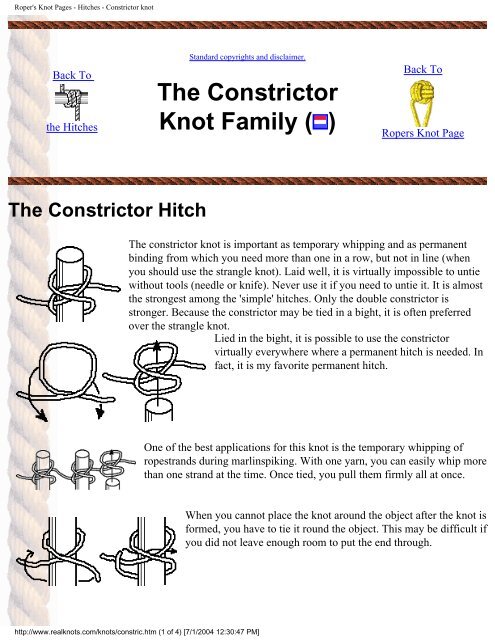Real Knots - Pole Shift Survival Information
Real Knots - Pole Shift Survival Information
Real Knots - Pole Shift Survival Information
You also want an ePaper? Increase the reach of your titles
YUMPU automatically turns print PDFs into web optimized ePapers that Google loves.
Roper's Knot Pages - Hitches - Constrictor knot<br />
Back To<br />
the Hitches<br />
Standard copyrights and disclaimer.<br />
The Constrictor<br />
Knot Family ( )<br />
Back To<br />
Ropers Knot Page<br />
The Constrictor Hitch<br />
The constrictor knot is important as temporary whipping and as permanent<br />
binding from which you need more than one in a row, but not in line (when<br />
you should use the strangle knot). Laid well, it is virtually impossible to untie<br />
without tools (needle or knife). Never use it if you need to untie it. It is almost<br />
the strongest among the 'simple' hitches. Only the double constrictor is<br />
stronger. Because the constrictor may be tied in a bight, it is often preferred<br />
over the strangle knot.<br />
Lied in the bight, it is possible to use the constrictor<br />
virtually everywhere where a permanent hitch is needed. In<br />
fact, it is my favorite permanent hitch.<br />
One of the best applications for this knot is the temporary whipping of<br />
ropestrands during marlinspiking. With one yarn, you can easily whip more<br />
than one strand at the time. Once tied, you pull them firmly all at once.<br />
When you cannot place the knot around the object after the knot is<br />
formed, you have to tie it round the object. This may be difficult if<br />
you did not leave enough room to put the end through.<br />
http://www.realknots.com/knots/constric.htm (1 of 4) [7/1/2004 12:30:47 PM]

















